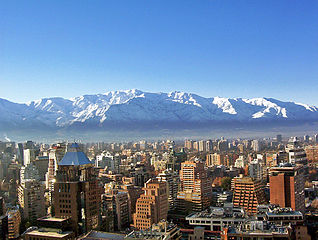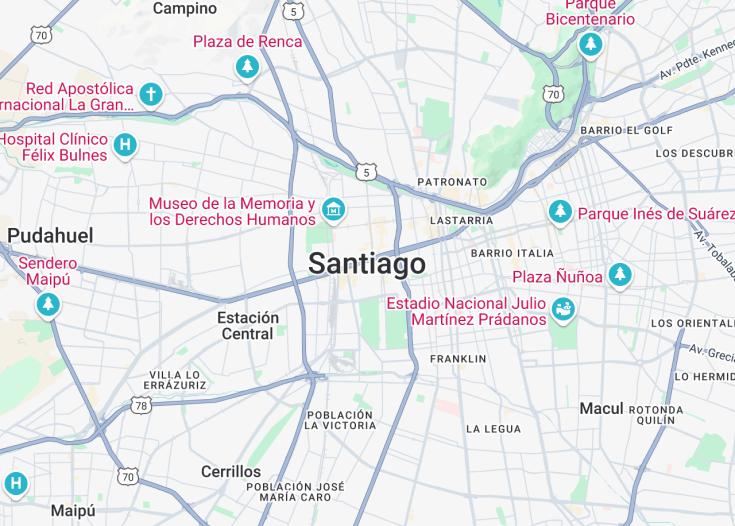Santiago, the vibrant capital of Chile, offers a compelling blend of modern urban landscapes and historic colonial structures. Nestled in a valley surrounded by the snow-capped Andes and Chilean Coast Range, this city captivates with its energetically diverse neighborhoods and rich cultural life. Visitors can explore numerous museums, expansive parks, and dynamic markets. An exemplary public transit system makes navigating through the city both efficient and comfortable. Moreover, Santiago serves as a central point for excursions to wine regions, mountainous areas, and coastal towns, ensuring a varied and enriching travel experience.
Remember to visit during March to May or September to November for pleasant weather, perfect for outdoor activities and exploring the city’s numerous festivals.
Explore the city’s green spaces such as Parque Forestal and Parque Metropolitano for a refreshing break from the bustling city life.
Top things to do & see in Santiago
Select the following sights and activities to discover best tickets and tours available in Santiago.
Santiago: The Cultural Heart of Chile
| Country | Chile |
| Time in Santiago | GMT-4 |
| Language spoken | Spanish |
| Population | 6,310,000 (World Urbanization Prospects 2022) |
| Currency | Chilean Peso (CLP $) |
| Airports | Comodoro Arturo Merino Benítez International Airport (15 mi / 24 km). |
Santiago, the capital of Chile, is not only the largest city in the country but also a bustling metropolis rich in history and culture. Nestled in the central valley at the foot of the Andean mountain range, Santiago offers breathtaking views juxtaposed with a skyscraper-filled skyline. Its colorful neighborhoods, such as Bellavista and Lastarria, blend historic architecture with contemporary street art, reflecting the city’s dynamic cultural mix.
The city’s origins date back to 1541, founded by Spanish conquistador Pedro de Valdivia. Santiago has grown from a colonial outpost into a vibrant urban center, the political, cultural, and economic heart of Chile. It houses important national monuments, museums, and libraries, including the La Moneda Palace and the National Museum of Fine Arts.
Santiago’s strategic location has made it a central hub in the network of Chilean cities, facilitating easy access to tourist attractions such as the Maipo Valley, famous for its vineyards, and nearby ski resorts, which are among the best in South America. The city also hosts numerous international festivals that attract global artists and contribute to its diverse cultural scene.
Despite modern advancements and its dense population, Santiago retains many green spaces, such as the Metropolitan Park, which is one of the largest urban parks in the world. This balance of urbanization and nature is a hallmark of the city, providing residents and visitors alike with breaths of fresh air amidst the urban landscape.
Santiago’s public transportation system, including its expanding metro network, stands out in Latin America for its efficiency and coverage. The city’s culinary scene mirrors its cultural diversity, where traditional Chilean dishes and international cuisine meet. Santiago’s economy is dynamic, marked by a high concentration of multinational corporations that stimulate its job market, making it a magnet for workers from across the country and other parts of Latin America.
Where is Santiago?
Santiago is centrally located in the Chilean central valley at the base of the Andes Mountains.
Distances:
| Route | Distance by car | Time by car |
|---|---|---|
| Valparaíso to Santiago | 75 miles (121 km) | Approx. 1.5 hours |
| Viña del Mar to Santiago | 78 miles (125 km) | Approx. 1.5 hours |
| San Bernardo to Santiago | 14 miles (22 km) | Approx. 30 minutes |
What is Santiago famous for?
Santiago is renowned for its vibrant cultural life, extensive museums and art galleries, and beautiful mountainous landscapes that offer various outdoor activities year-round.
History
Pre-Columbian Period
Before the arrival of the Spanish conquistadors, the area now known as Santiago was inhabited by indigenous Picunche tribes, who were part of the larger Mapuche groups. These indigenous peoples lived by farming beans, maize, and squashes while also engaging in hunting and gathering.
1541: Foundation of Santiago
On February 12, 1541, Pedro de Valdivia, a Spanish conquistador, officially founded Santiago de Nueva Extremadura in honor of Saint James. Valdivia chose the location for its moderate climate and strategic position along the Mapocho River. The early years were troublesome, marked by frequent attacks from local indigenous tribes, as well as limited resources.
Colonial Era (1541–1810)
During Chile’s colonial period, Santiago slowly evolved into a significant administrative and religious center. The construction of significant landmarks like the San Francisco Church in the late 16th century marks this era. Over time, the city saw the establishment of the Royal Audiencia (high court), and by the 18th century, it was the capital of the Captaincy General of Chile, a Spanish colonial administrative district.
19th Century: Independence and Growth
Throughout the 19th century, Santiago witnessed several pivotal events, including the Chilean War of Independence against Spain. Bernardo O’Higgins officially declared independence in 1818. Following independence, Santiago began to see substantial growth. The construction of the Universidad de Chile in 1842 and the expansion of urban infrastructure marked this era of modernization and increased influence.
20th Century to Present
In the 20th century, Santiago experienced rapid industrialization and population growth, transforming into a bustling metropolitan hub. Landmark events include the electoral victory of Salvador Allende in 1970 and the subsequent military coup in 1973. Recent decades have emphasized modernization, with significant improvements in public transportation, like the introduction of the Metro de Santiago, and educational reforms. Today, Santiago stands as a dynamic capital reflecting both rich heritage and contemporary progress.
Visit Santiago
What to see and do in Santiago, Chile
One can find varied attractions within Santiago. Start at the heart of the city in Plaza de Armas, where historical buildings like the Santiago Metropolitan Cathedral stand. Art enthusiasts will enjoy visiting the Chilean National Museum of Fine Arts. For a glimpse of local life, explore Barrio Bellavista, known for its vibrant nightlife and artistic murals. Nature lovers can trek up San Cristóbal Hill for panoramic city views.
- Plaza de Armas
- Santiago Metropolitan Cathedral
- Chilean National Museum of Fine Arts
- Barrio Bellavista
- San Cristóbal Hill
Key Events in Santiago
Santiago hosts various cultural and social events throughout the year. Consider the Santiago a Mil festival, held every January, featuring street performances and theatre. Another significant event is the Vendimia festival in March, celebrating local wine production with tastings and entertainment.
Best time to visit Santiago
The best time to visit Santiago is during the spring months from September to November or the autumn period from March to May. During these times, the weather is pleasant, and the city’s parks and gardens bloom vividly, offering a magical backdrop for sightseeing.
Is Santiago worth visiting?
Santiago is undoubtedly worth a visit. As a cultural and historical hub of Chile, it not only offers insights into the country’s past but also boasts vibrant street art, bustling markets, and stunning architecture. The city is surrounded by nature, from hills offering scenic views to nearby vineyards inviting you to unwind and enjoy Chile’s famous wines. Whether interested in history, culture, or simply looking to indulge in gastronomic delights, Santiago provides a well-rounded travel experience.









